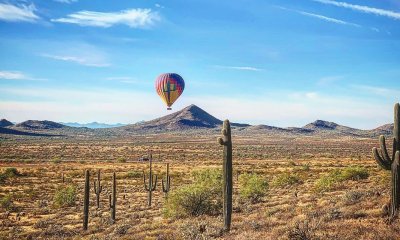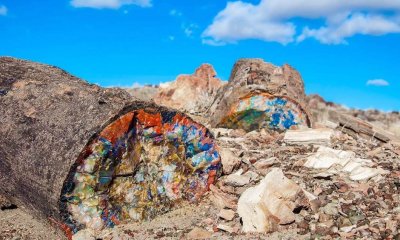Florida
Planning To Go Bird-Watching? Here Are The Birds of Florida That You Need To Watch Out For
Florida is one great state to be in if you have a ton of hobbies you want to hone. And yes, if you’re thinking about making bird-watching one of your hobbies or maybe turning it into a career, Florida is home to a wide range of birds you can see in different seasons.
Here are some of the birds of Florida that you need to watch out for. Organized by color, now you don’t have to scramble what type of bird you just saw. Whether it’s black, pink, brown, green, yellow, or blue — this list has got you! To make your bird-watching experience even better, some birds here can be found tweeting around in your backyard if you don’t want to go on a hiking adventure that much.
Black Birds in Florida
Brewer’s Blackbird
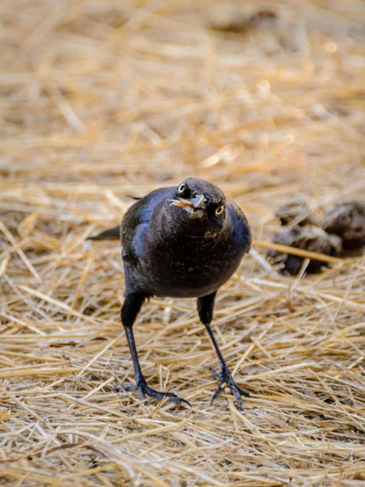
Source: https://www.onthefeeder.com/birds-of-florida/
Brewer’s Blackbirds are migratory birds with diets consisting of insects, seeds, and berries. They inhabit open woodlands, mountain meadows, city sidewalks, and suburban backyards. Although there’s a possibility that you might be able to see Brewer’s Blackbirds all year round, some of these iridescent birds head north and east in spring to breed and raise their young.
The Brewer’s Blackbirds’ nests are built around 20 to 40 feet. It is comprised of twigs, grasses, and other plant materials.
Eastern Kingbird
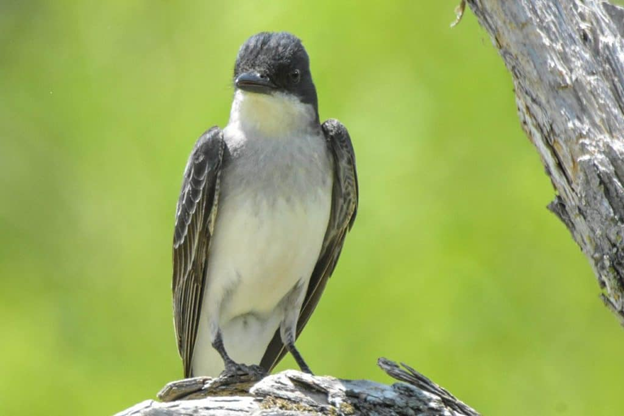
Source: https://www.onthefeeder.com/birds-of-florida/
Eastern Kingbirds are unlikely to visit bird feeders, so if you have one and are waiting for an Eastern Kingbird, you won’t likely witness one. Its diet is mostly fruit and insects, and they inhabit prairies and fields. If you’re keeping an eye out for an Eastern Kingbird, watch out for the following details: mostly charcoal gray with a black head, white belly, and white chin; a white band that goes across the end of their tail; and a red crown that is most likely concealed.
Black and White Warbler
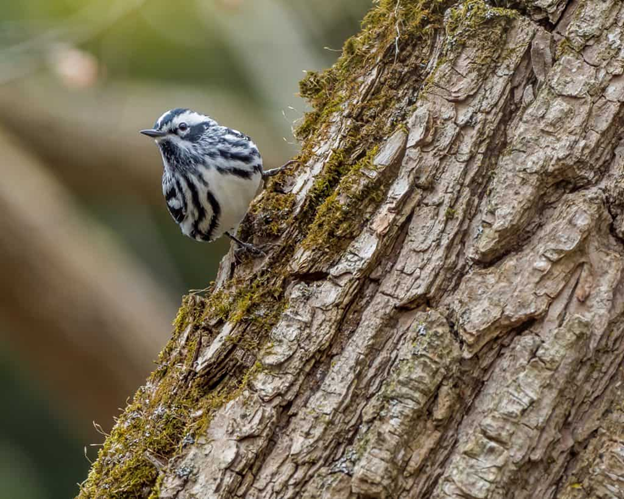
Source: https://www.onthefeeder.com/birds-of-florida/
The Black and White Warbler is a small bird, only measuring up to 5” long. It is similar to a zebra with its black and white stripes, although the Black and White Warbler has a white belly and black chin with black patches on its cheeks. If you see a Black and White Warbler that looks duller, it is a female.
Its diet usually consists of insects, and it usually shies away from the bird feeder. The Black and White Warbler inhabits deciduous as well as mixed forests.
Carolina Chickadee
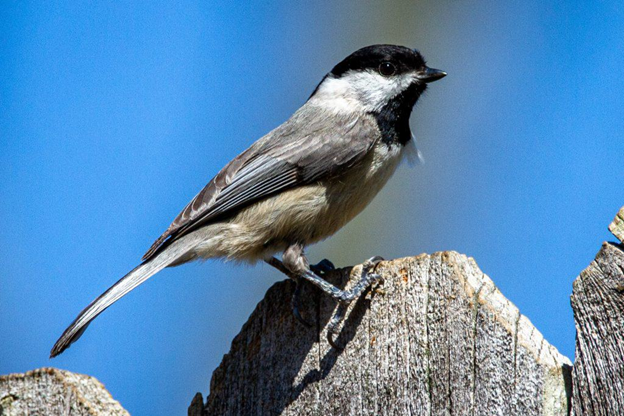
Source: https://www.onthefeeder.com/birds-of-florida/
The Carolina Chickadee is yet another small bird in Florida’s roster. It only grows up to 5” long and is primarily gray on top and white underneath. It has a black cap and throat along with white cheeks. The Carolina Chickadee loves insects, spiders, seeds, and small fruits. If you have a bird feeder, put some sunflower seeds, peanut chips, and suet for the Carolina Chickadee.
It places its nests in the woodlands, wooded edges, suburbs, and city parks. The Carolina Chickadee is not a migratory bird which means they are one of the most commonly seen birds around the sunny state of Florida.
American Redstart
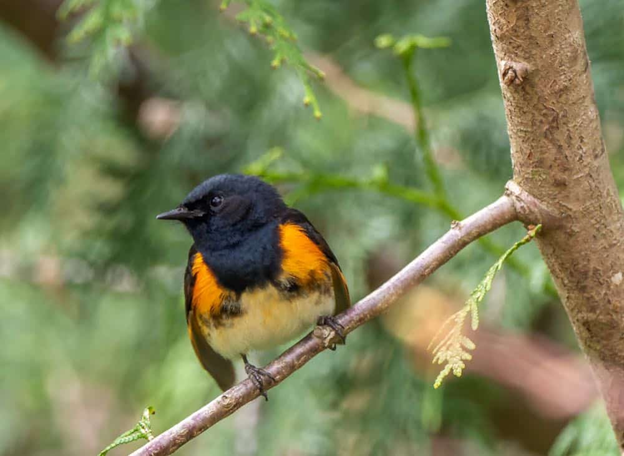
Source: https://www.onthefeeder.com/birds-of-florida/
The American Redstart is a small yet stout bird that can only grow about 4.5-5” long. It can be found in open wooded areas, especially those with deciduous trees, in every contiguous US state and part of Canada. The American Redstart loves to feed on insects, small berries, and fruits from shrubs, although they are unlikely to visit a bird feeder.
The characteristics you should look out for in an American Redstart are its mostly black body, white belly, orange stripes, and patches on the tail, wings, and sides.
Baltimore Oriole

Source: https://www.onthefeeder.com/birds-of-florida/
The Baltimore Oriole can be found in residential areas and wooded edges with deciduous shady trees. They often take rests near natural water sources such as ponds and rivers and love to feed on insects, berries, and nectar from flowers. If you set up a bird feeder, add sweet food such as nectar, oranges, and regular grape jelly.
The Baltimore Oriole has a black head, white wing bars, and a bright orange body. However, a female Baltimore Oriole has a pale yellow head and body with grayish-brown wings.
Pink Birds in Florida
American Flamingo
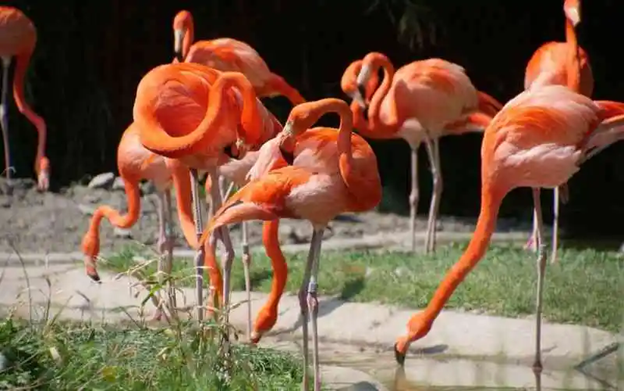
Source: https://www.onthefeeder.com/birds-of-florida/
Commonly spotted in zoos nowadays, the American Flamingo is still the star of the show for bird watchers and zoo-goers alike. They are found in coastal areas in southern Florida, such as the Florida Keys, the Everglades, and the Gulf Coast.
The American Flamingo can grow up to 57 inches tall and can be identified by their fully pink legs, pink wings, and goose-like honking. Their diet includes algae, tiny seeds, brine, shrimp, mollusks, worms, small fish, grass, seeds, crustaceans, and sometimes mud.
Roseate Spoonbill
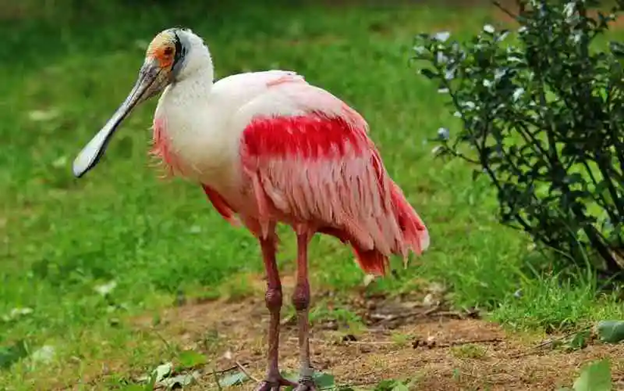
Source: https://www.onthefeeder.com/birds-of-florida/
The Roseate Spoonbill is a very large pink bird in Florida. They sometimes get mistaken for an American Flamingo, but you can easily differentiate the Roseate Spoonbill by their featherless heads and long spoon-shaped bills. They can grow up to 34 inches long with a wingspan of 47-52 inches.
If you are looking for a Roseate Spoonbill, make sure to spot ibises, herons, and egrets, too, because they nest along with them in groups around mangroves, forested swamps, bays, and wetlands, yet they nest on trees.
Galah
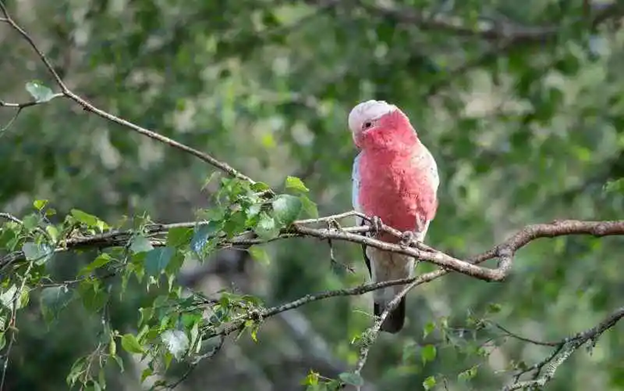
Source: https://www.onthefeeder.com/birds-of-florida/
Opting for a smaller pink bird? The Galah might be what you’re looking for. It belongs to the cockatoo family and is also known as the pink and gray cockatoo, red-breasted cockatoo, or roseate cockatoo. Although the Galah can be found in Florida, it is a migratory bird species and not native to the sunny state. The Galah prefers to stay in groups or trees, and their diet consists of seeds, grains, nuts, berries, grasses, green shoots, leaves, and barks of trees.
Scarlet Ibis
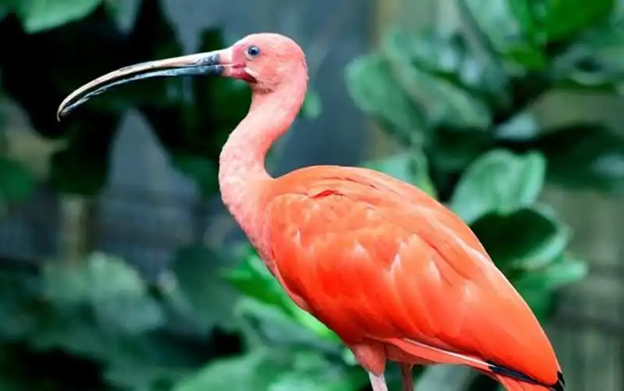
Source: https://www.onthefeeder.com/birds-of-florida/
The Scarlet Ibis is a medium-sized bird native to South America, the Caribbean, and Central America, but you can also find them near or in bodies of water in Florida. They feed on small aquatic creatures, insects, beetles, shrimp, small crabs, mollusks, crustaceans, and small fish.
You can differentiate the Scarlet Ibis from the American Flamingo by its bright red color with black wings and black tail. The Scarlet Ibis is also Trinidad and Tobago’s national bird.
Purple Finch
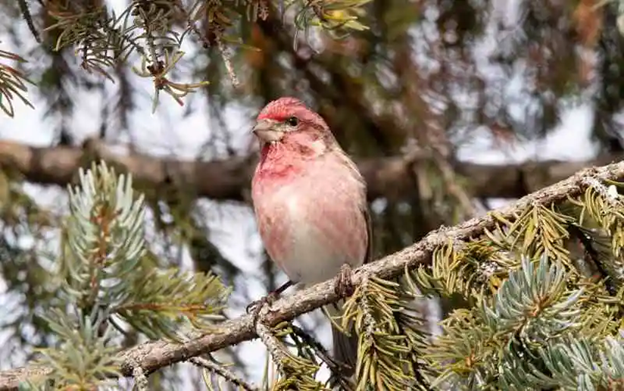
Source: https://www.onthefeeder.com/birds-of-florida/
The Purple Finch is a small bird native to North America but can be sighted in Florida during the winter months in the northern part of the state. These cute birds mainly eat seeds, insects, and fruits. The Purple Finch can be found in mixed forests, parks, and gardens with mature trees. They only grow up to 5.5 inches in length with a wingspan of 9 inches.
House Finch
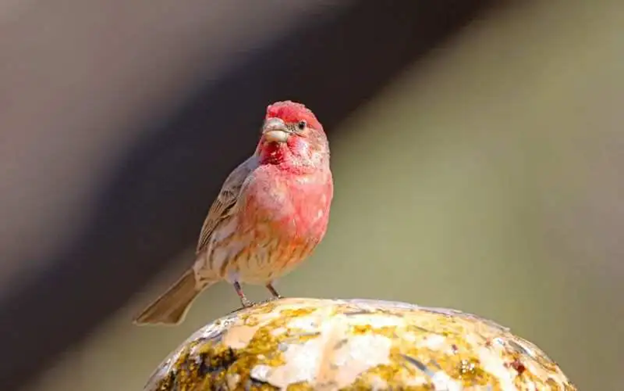
Source: https://www.onthefeeder.com/birds-of-florida/
The House Finch, commonly mistaken for the Purple Finch, is a small pinkish bird native to Florida and North America. They eat thistle, dandelion, sunflower seeds, insects, and fruits and commonly set up their nests in the open woodlands, suburban areas, parks, and gardens.
You can differentiate the House Finch from the Purple Finch by its red head, breasts with brown streaks, and brown back. The House Finch is also known for their melodic songs.
Brown Birds in Florida
American Robin
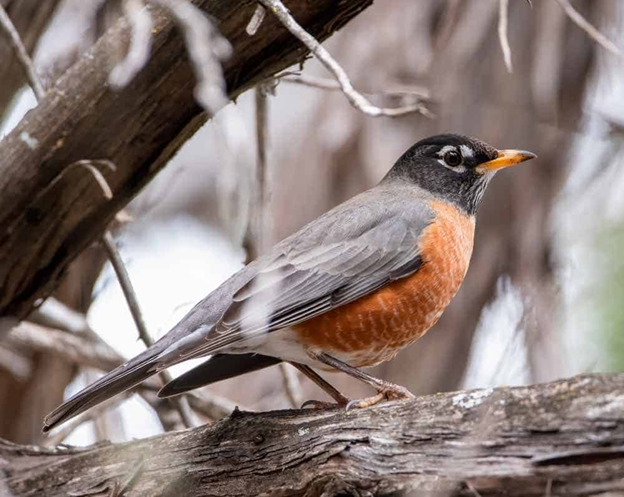
Source: https://www.onthefeeder.com/birds-of-florida/
The American Robin is common throughout the US and Canada and can be found in fields, parks, wooded and forested areas, mountains, and backyards. They feed on earthworms, insects, and fruits, although they don’t like to visit bird feeders. It is a medium-sized bird that can grow only up to 10” long and can be distinguished by its gray/brown upper, brow/orange underparts, yellow beak, white chin, and white surrounding eyes. It’s also important to note that the American Robin is a migratory bird.
Brown Creeper
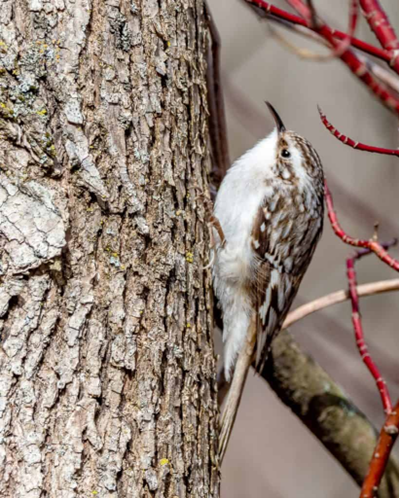
Source: https://www.onthefeeder.com/birds-of-florida/
The Brown Creeper is yet another small bird of Florida that can only grow up to 5” long. They feed on insects, nuts, and seeds around forested areas. The Brown Creeper also frequently visits bird feeders that contain hulled sunflower seeds, suet, and hulled peanuts. They are known for their brown body, white belly, long tail, and thin curved bill. Brown Creeper females look the same as males.
Brown Thrasher
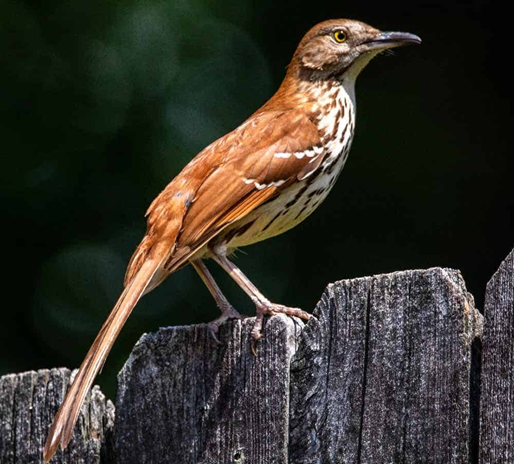
Source: https://www.onthefeeder.com/birds-of-florida/
The Brown Thrasher is a rusty red bird that can grow until it is about 11” long. It has a long, thin tail, heavily streaked chest and belly, long curved bill, and bright yellow eyes. It feeds on insects and fruits and is not a common feeder bird but may stop and feed on fallen seeds. The Brown Thrasher lives in thick shrubs, wooded edges, hedgerows, tree lines, fence rows, and woodlands.
Brown-headed Cowbird
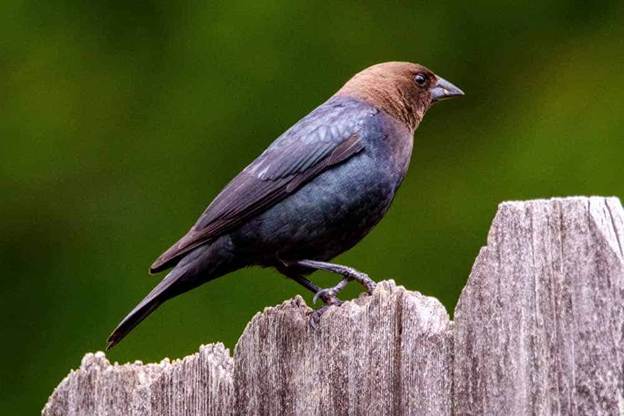
Source: https://www.onthefeeder.com/birds-of-florida/
The Brown-headed Cowbird is known for not building nests, yet they lay around 5-7 white eggs with brown markings in other birds’ nests. It is a medium-sized bird growing up to 7 ½” long. It feeds on insects and seeds and mixed bird seeds, too. The Brown-headed Cowbird lives in thick shrubs, wooded edges, hedgerows, tree lines, fence rows, and woodlands. It has a glossy back with a chocolate brown head and a long, pointed gray bill, while the female is a dull brownish gray.
Carolina Wren
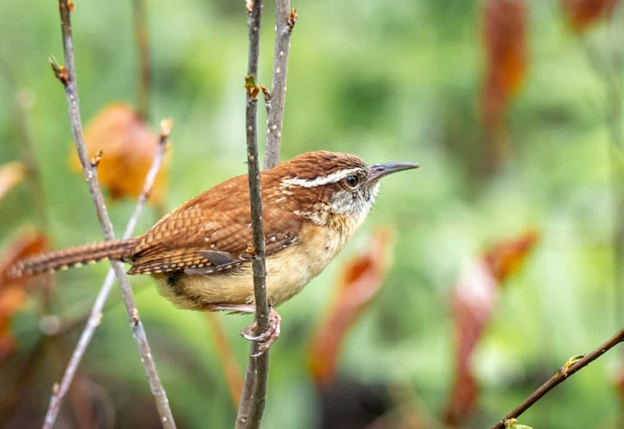
Source: https://www.onthefeeder.com/birds-of-florida/
The Carolina Wren is a small but chunky bird that feeds on insects and spiders and lives in brushy woods and wooded backyards. They love feeders and enjoy hulled sunflower seeds, mealworms, peanut hearts, and suet. The Carolina Wren can grow about 5 ½” long and is known for its deep rusty brown head and cinnamon-colored body.
Cedar Waxwing
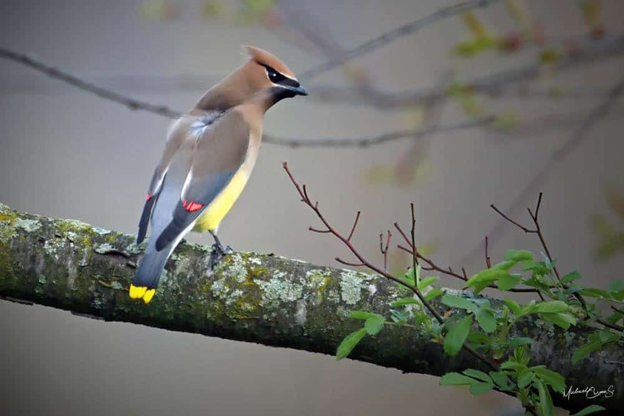
Source: https://www.onthefeeder.com/birds-of-florida/
The Cedar Waxwing frequents open forests, orchards, wooded residential areas, and near berry bushes. They feed mostly on fruit and insects but prefer to eat oranges on feeders. The Cedar Waxwing grows up to 7 ¼” long and can be distinguished by its light brown head, yellow belly, bright yellow tip on the tail, and varying shades of brown.
Green Birds in Florida
Black-throated Green Warbler
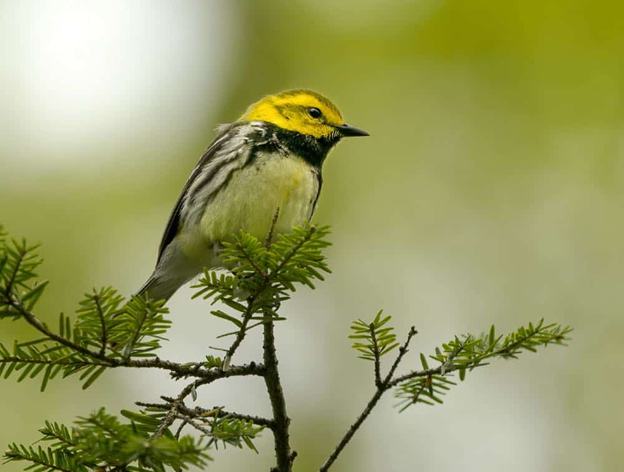
Source: https://www.onthefeeder.com/birds-of-florida/
The Black-Throated Green Warbler is a small bird that commonly feeds on insects and berries; they don’t like to visit feeders. It is a migratory bird that prefers forests with a mix of coniferous and deciduous trees. The Black-Throated Green Warbler grows up to 4.5” long and is known for its bright yellow head, black throat, and greenback. The female looks similar but has a white throat.
Monk Parakeet
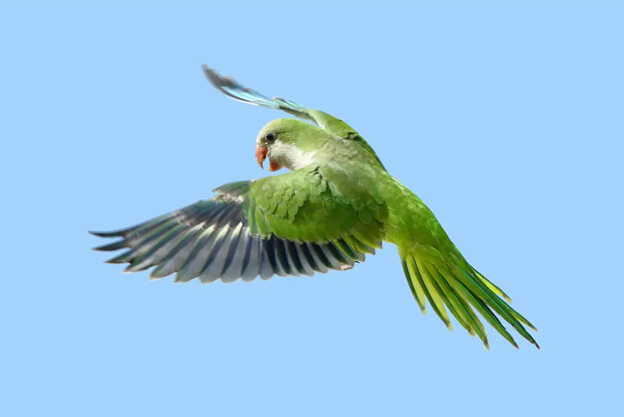
Source: https://www.onthefeeder.com/birds-of-florida/
The Monk Parakeet is the most prevalent green bird species in Florida. Although they resemble little macaws, the Monk Parakeet can be distinguished by their white underparts and blue heads. They feed on fruits, berries, buds, flowers, and seeds. You can hear them whistle in high pitches throughout the breeding season.
Green Budgerigar
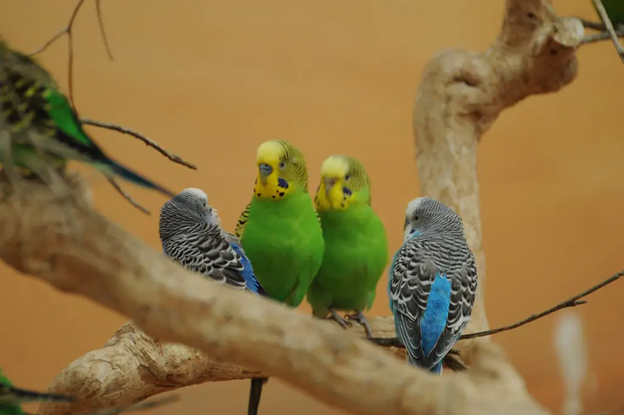
Source: https://www.onthefeeder.com/birds-of-florida/
The Green Budgerigar is native to Australia and New Guinea but can also be found in Florida. These Budgerigars are commonly seen around Florida’s 67 counties and like playing with toys. The Green Budgerigar’s diet includes insects, spiders, worms, and other invertebrates.
Nanday Parakeet
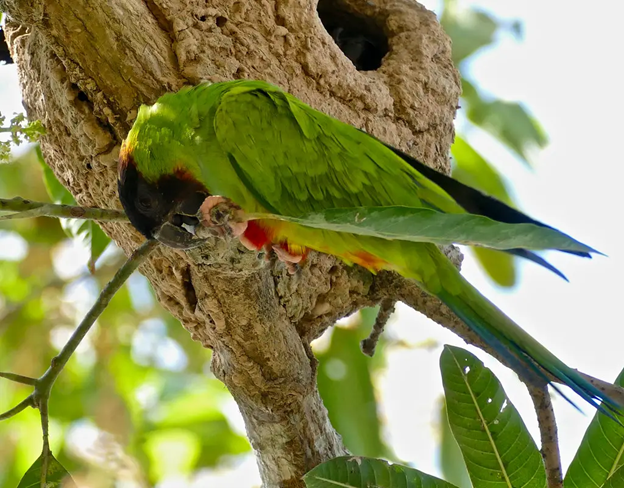
Source: https://birdsology.com/green-birds-in-florida/
The Nanday Parakeet can be found in several locations in South Florida. It is mostly green with a black head and orange feet and feeds on fruit, seeds, nuts, and insects. You can commonly find them in Palm Beach, Miami, Tampa Bay, and St. Petersburg. Their loud and recognizable sounds can distinguish the Nanday Parakeet during the dawn and the sunset.
Rose-ringed Parakeet
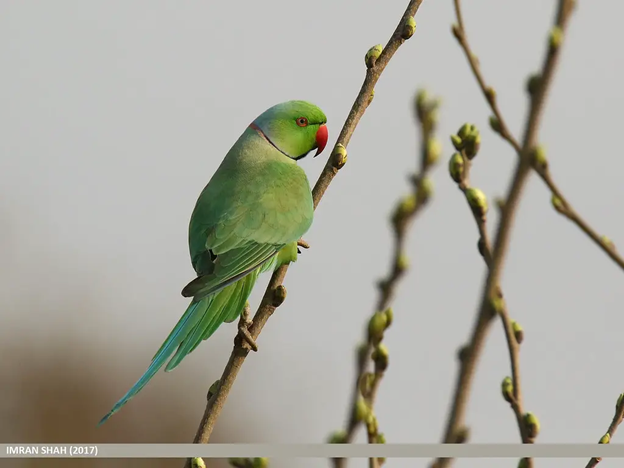
Source: https://birdsology.com/green-birds-in-florida/
The Rose-Ringed Parakeet, also known as the Ring-necked Parakeet, is a species of bird that can be seen year-round in Florida. Its diet comprises fruits, seeds, nuts, insects, and worms.
Buff-Bellied Hummingbird
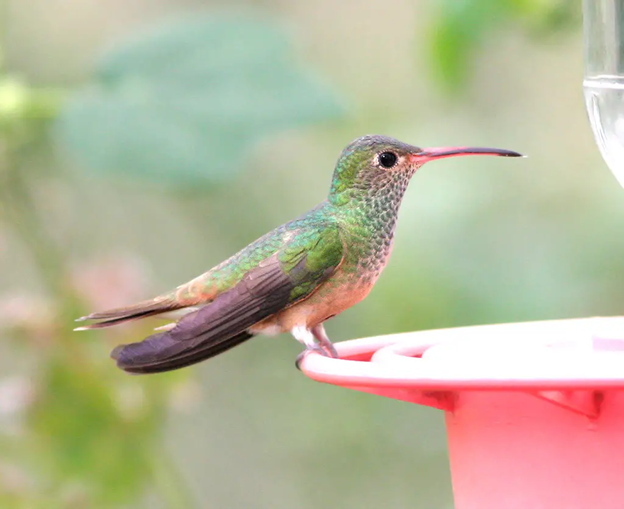
Source: https://birdsology.com/green-birds-in-florida/
The Buff-Bellied Hummingbird is sometimes mistaken for other species of birds due to their long thin beak and small body. However, it can be distinguished by its emerald green color and its dark brown wings and tail. These small birds feed on nectar sources and tiny insects and inhabit acacia and mesquite forests.
Yellow Birds in Florida
American Goldfinch
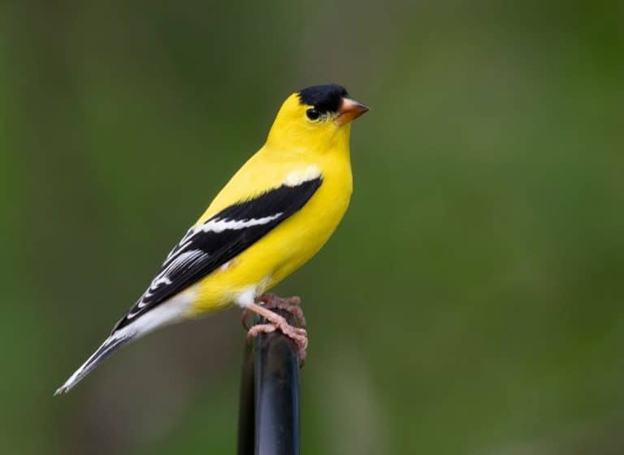
Source: https://birdsology.com/green-birds-in-florida/
The American Goldfinch are partially migratory birds, yet many remain in Florida all year round. They feed on seeds, weeds, grasses, small trees, and insects. If you set up a feeder for the American Goldfinch, put lots of thistle seeds. Look for the American Goldfinch in weedy fields, roadsides, orchards, and backyards. These small birds that can grow only up to 4.5” long can be distinguished by their yellow body, black wings with white stripes, black forehead, and short orange beak.
Common Yellowthroat
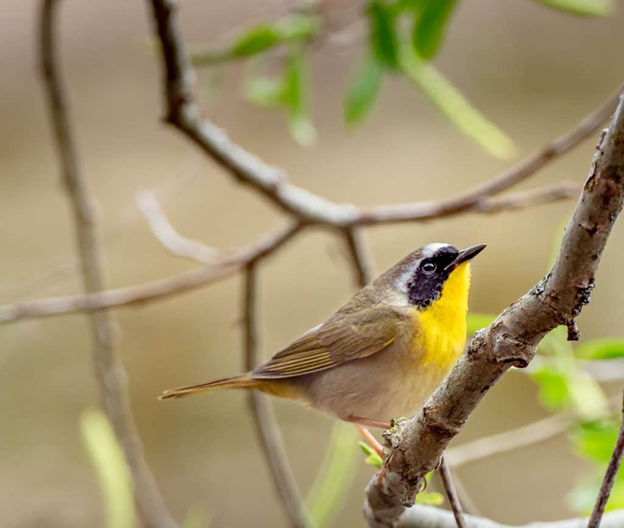
Source: https://www.onthefeeder.com/birds-of-florida/
The Common Yellowthroat is a small bird that feeds on insects and doesn’t visit feeders. It inhabits thick brushes, open fields, and marshes and is known for its olive-brown color, bright yellow throat and breasts, and white belly.
Connecticut Warbler
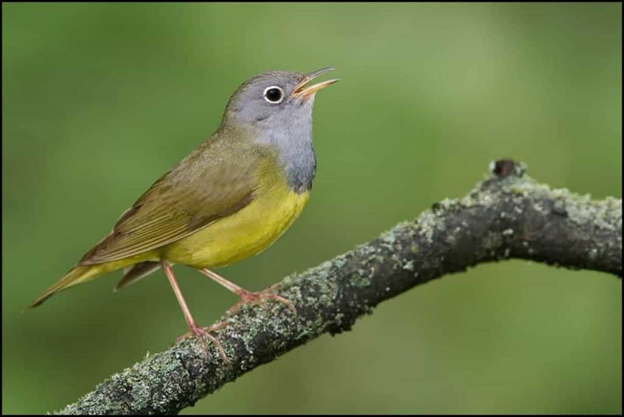
Source: https://www.onthefeeder.com/birds-of-florida/
The Connecticut Warbler is another small bird species frequenting Florida’s open woodland and wet marshy areas. It feeds on insects and spiders and is one of the birds that are not likely to visit a feeder. The Connecticut Warbler is known for its small body, gray head, white eyering, yellow belly, and brownish wings.
Golden-wined Warbler
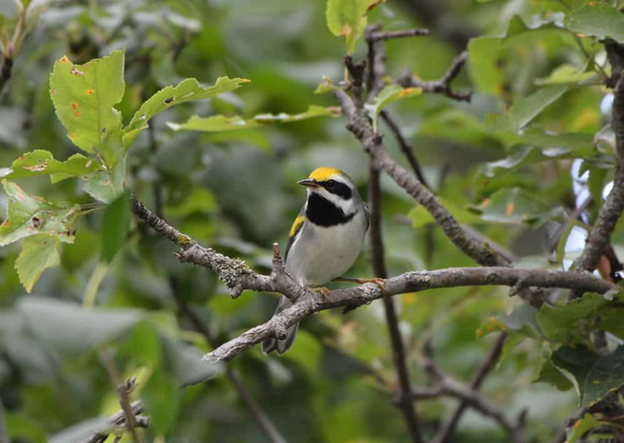
Source: https://www.onthefeeder.com/birds-of-florida/
The Golden-Winged Warbler is a small bird that can grow only up to 5” long, feeds on insects, and doesn’t love to visit feeders. The forest is their primary habitat except during the breeding season, where they can be found in shrubby open areas instead. The Golden-Winged Warbler is known for its short tail and thin pointy bill.
White-eyed Vireo
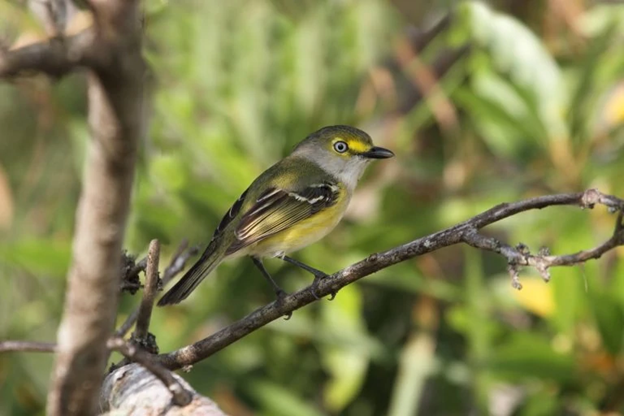
Source: https://www.birdadvisors.com/yellow-birds-florida/
The White-Eyed Vireo can be spotted in Florida all year round. It has a gray head with yellow around its foreheads and white eyes. You can find them in overgrown pastures and brambles, and they feed on insects, flies, spiders, and berries.
Prairie Warbler
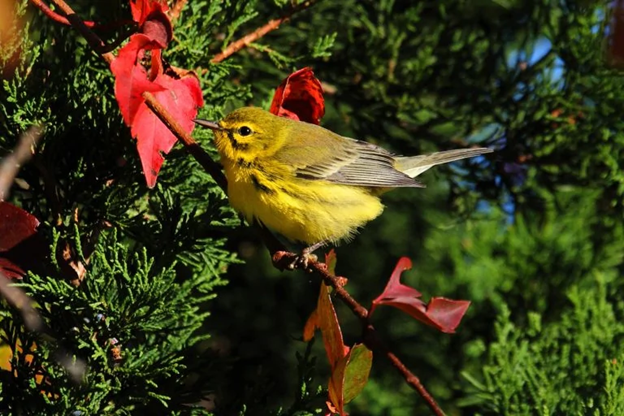
Source: https://www.birdadvisors.com/yellow-birds-florida/
The Prairie Warbler spends its breeding season in Northern Florida from March to April and September to October. It lives in fields and forests, eating insects, spiders, and snails. Prairie Warblers are known to bob their tails while looking for food. They have an olive green back and yellow throat and belly.
Blue Birds in Florida
Barn Swallow
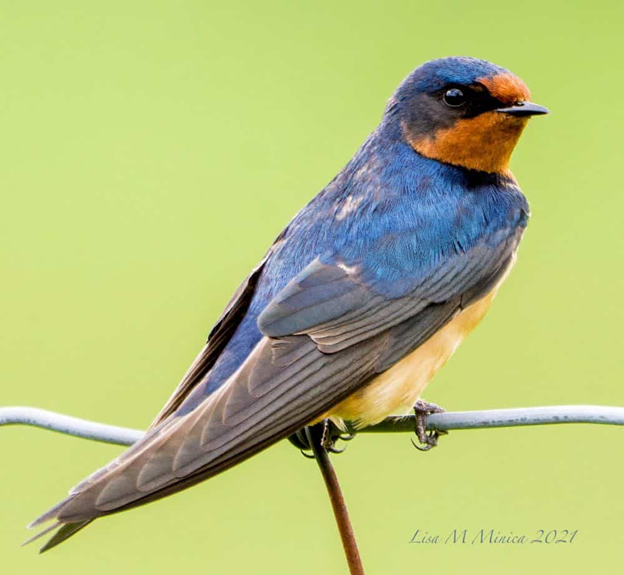
Source: https://www.onthefeeder.com/birds-of-florida/
The Barn Swallow is a 7” migratory bird that typically builds its nests in or on manmade structures such as barns. Their diet consists of insects, preferably beetles, wasps, and flies. They are known for their steel blue glossy head, chestnut forehead and throat, and rust-orange underparts.
Black-throated Blue Warbler
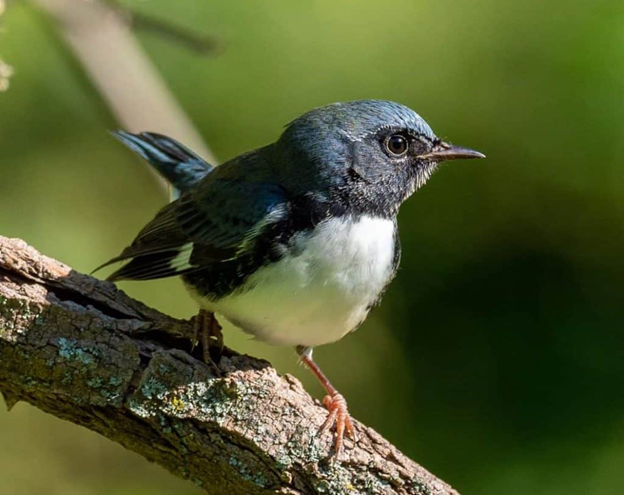
Source: https://www.onthefeeder.com/birds-of-florida/
The Black-Throated Blue Warbler is a small bird that feeds on insects and fruits and feeder food such as suet, peanut butter, and nectar. It lives in deciduous forests and mixed evergreen woodlands. The Black-Throated Blue Warbler is a migratory bird that heads north during spring to breed and raise its young. In the fall, they go back to Florida.
Blue Grosbeak
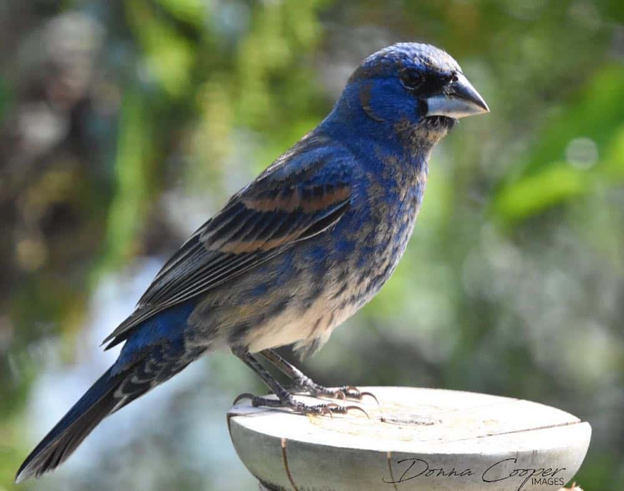
Source: https://www.onthefeeder.com/birds-of-florida/
The Blue Grosbeak is a medium-sized migratory bird known for its large silver bills and chestnut wing bars. It feeds on insects, seeds, and grains and can be found in thick shrubbery areas with tall trees. The Blue Grosbeak migrate to the north to breed and raise their young during spring and return to Florida during the fall.
Blue Jay
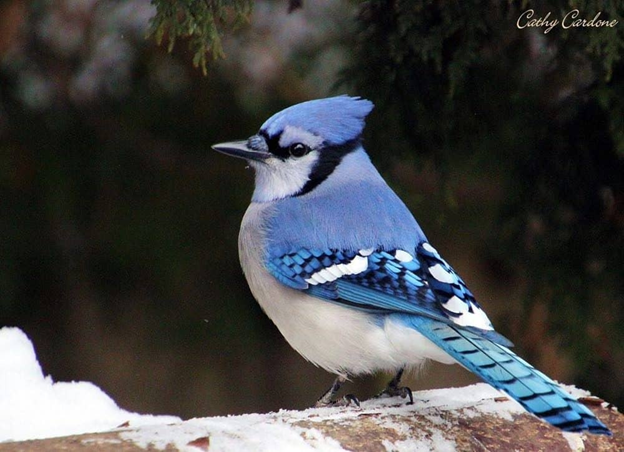
Source: https://www.onthefeeder.com/birds-of-florida/
The Blue Jay is a large bird (12” long) with a medium blue and white body, blue crest, gray belly, and white face. It feeds on insects, fruit, seeds, nuts, other birds’ eggs, and nestlings, and it also loves feeder food such as whole peanuts, sunflower seeds, and cracked corn. You can find the Blue Jay in forested areas with mixed tree types, in the suburbs and in urban areas. The Blue Jay is not a migratory bird.
Blue-gray Gnatcatcher
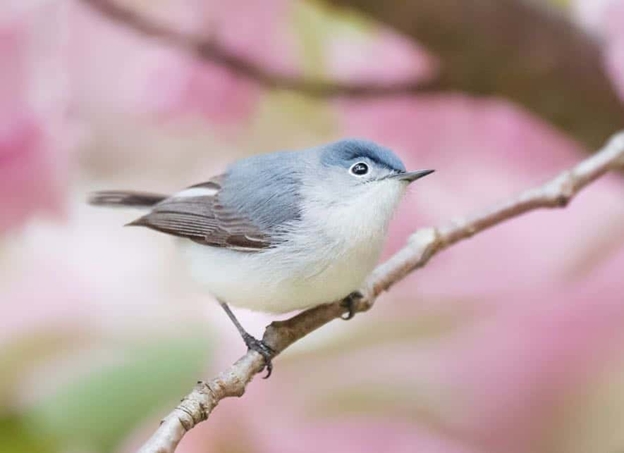
Source: https://www.onthefeeder.com/birds-of-florida/
The Blue-Gray Gnatcatcher is a migratory bird that mostly migrates north of the US to breed and raise its young and returns to Florida during the fall. It feeds on insects and spiders and cannot be found near feeders. The Blue-Gray Gnatcatcher lives in deciduous forested areas and can grow only up to 4.25” long. It is known for its blue-gray upperparts, white earrings, underparts, and long black tails.
Common Grackle
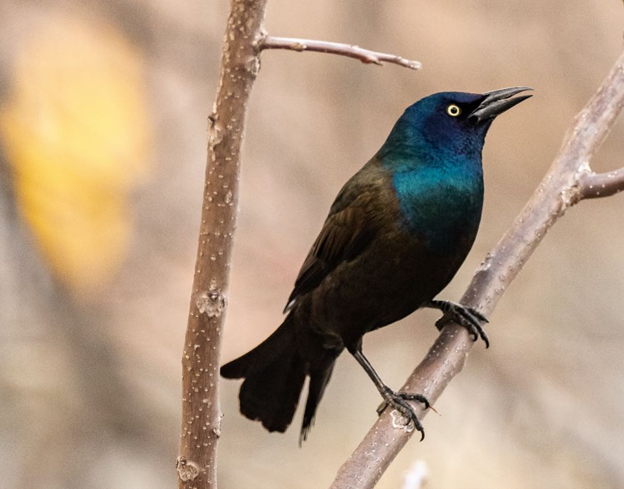
Source: https://www.onthefeeder.com/birds-of-florida/
The Common Grackle is a large bird that can grow up to 12.5” long and is known for its iridescent blue, purple, and bronze colors. It feeds on insects, grains, seeds, fruits, and scavenged garbage, and it also loves to visit feeders that contain sunflower seeds and black-oil sunflower seeds. The Common Grackle is found in fields with scattered trees, open woodlands, farmlands, marshes, and suburban yards. Surprisingly, the Common Grackle is a migratory bird that heads north to breed and raise its young and return to Florida during the fall season.
Prepare your cameras and binoculars and wait patiently for these birds not commonly seen in the Sunshine State throughout the year. These are great additions to your bird-watching photo collection. And if you’re just getting started, some easy-to-catch birds are on the list, too. Happy bird-watching!












